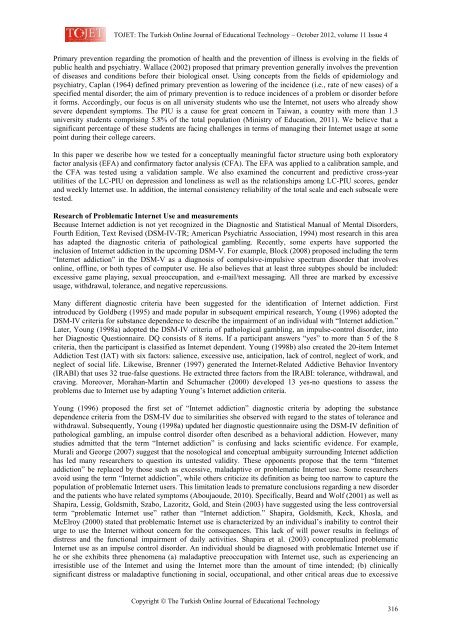october 2012 - TOJET the Turkish online journal of educational ...
october 2012 - TOJET the Turkish online journal of educational ...
october 2012 - TOJET the Turkish online journal of educational ...
Create successful ePaper yourself
Turn your PDF publications into a flip-book with our unique Google optimized e-Paper software.
<strong>TOJET</strong>: The <strong>Turkish</strong> Online Journal <strong>of</strong> Educational Technology – October <strong>2012</strong>, volume 11 Issue 4<br />
Primary prevention regarding <strong>the</strong> promotion <strong>of</strong> health and <strong>the</strong> prevention <strong>of</strong> illness is evolving in <strong>the</strong> fields <strong>of</strong><br />
public health and psychiatry. Wallace (2002) proposed that primary prevention generally involves <strong>the</strong> prevention<br />
<strong>of</strong> diseases and conditions before <strong>the</strong>ir biological onset. Using concepts from <strong>the</strong> fields <strong>of</strong> epidemiology and<br />
psychiatry, Caplan (1964) defined primary prevention as lowering <strong>of</strong> <strong>the</strong> incidence (i.e., rate <strong>of</strong> new cases) <strong>of</strong> a<br />
specified mental disorder; <strong>the</strong> aim <strong>of</strong> primary prevention is to reduce incidences <strong>of</strong> a problem or disorder before<br />
it forms. Accordingly, our focus is on all university students who use <strong>the</strong> Internet, not users who already show<br />
severe dependent symptoms. The PIU is a cause for great concern in Taiwan, a country with more than 1.3<br />
university students comprising 5.8% <strong>of</strong> <strong>the</strong> total population (Ministry <strong>of</strong> Education, 2011). We believe that a<br />
significant percentage <strong>of</strong> <strong>the</strong>se students are facing challenges in terms <strong>of</strong> managing <strong>the</strong>ir Internet usage at some<br />
point during <strong>the</strong>ir college careers.<br />
In this paper we describe how we tested for a conceptually meaningful factor structure using both exploratory<br />
factor analysis (EFA) and confirmatory factor analysis (CFA). The EFA was applied to a calibration sample, and<br />
<strong>the</strong> CFA was tested using a validation sample. We also examined <strong>the</strong> concurrent and predictive cross-year<br />
utilities <strong>of</strong> <strong>the</strong> LC-PIU on depression and loneliness as well as <strong>the</strong> relationships among LC-PIU scores, gender<br />
and weekly Internet use. In addition, <strong>the</strong> internal consistency reliability <strong>of</strong> <strong>the</strong> total scale and each subscale were<br />
tested.<br />
Research <strong>of</strong> Problematic Internet Use and measurements<br />
Because Internet addiction is not yet recognized in <strong>the</strong> Diagnostic and Statistical Manual <strong>of</strong> Mental Disorders,<br />
Fourth Edition, Text Revised (DSM-IV-TR; American Psychiatric Association, 1994) most research in this area<br />
has adapted <strong>the</strong> diagnostic criteria <strong>of</strong> pathological gambling. Recently, some experts have supported <strong>the</strong><br />
inclusion <strong>of</strong> Internet addiction in <strong>the</strong> upcoming DSM-V. For example, Block (2008) proposed including <strong>the</strong> term<br />
“Internet addiction” in <strong>the</strong> DSM-V as a diagnosis <strong>of</strong> compulsive-impulsive spectrum disorder that involves<br />
<strong>online</strong>, <strong>of</strong>fline, or both types <strong>of</strong> computer use. He also believes that at least three subtypes should be included:<br />
excessive game playing, sexual preoccupation, and e-mail/text messaging. All three are marked by excessive<br />
usage, withdrawal, tolerance, and negative repercussions.<br />
Many different diagnostic criteria have been suggested for <strong>the</strong> identification <strong>of</strong> Internet addiction. First<br />
introduced by Goldberg (1995) and made popular in subsequent empirical research, Young (1996) adopted <strong>the</strong><br />
DSM-IV criteria for substance dependence to describe <strong>the</strong> impairment <strong>of</strong> an individual with “Internet addiction.”<br />
Later, Young (1998a) adopted <strong>the</strong> DSM-IV criteria <strong>of</strong> pathological gambling, an impulse-control disorder, into<br />
her Diagnostic Questionnaire. DQ consists <strong>of</strong> 8 items. If a participant answers “yes” to more than 5 <strong>of</strong> <strong>the</strong> 8<br />
criteria, <strong>the</strong>n <strong>the</strong> participant is classified as Internet dependent. Young (1998b) also created <strong>the</strong> 20-item Internet<br />
Addiction Test (IAT) with six factors: salience, excessive use, anticipation, lack <strong>of</strong> control, neglect <strong>of</strong> work, and<br />
neglect <strong>of</strong> social life. Likewise, Brenner (1997) generated <strong>the</strong> Internet-Related Addictive Behavior Inventory<br />
(IRABI) that uses 32 true-false questions. He extracted three factors from <strong>the</strong> IRABI: tolerance, withdrawal, and<br />
craving. Moreover, Morahan-Martin and Schumacher (2000) developed 13 yes-no questions to assess <strong>the</strong><br />
problems due to Internet use by adapting Young’s Internet addiction criteria.<br />
Young (1996) proposed <strong>the</strong> first set <strong>of</strong> “Internet addiction” diagnostic criteria by adopting <strong>the</strong> substance<br />
dependence criteria from <strong>the</strong> DSM-IV due to similarities she observed with regard to <strong>the</strong> states <strong>of</strong> tolerance and<br />
withdrawal. Subsequently, Young (1998a) updated her diagnostic questionnaire using <strong>the</strong> DSM-IV definition <strong>of</strong><br />
pathological gambling, an impulse control disorder <strong>of</strong>ten described as a behavioral addiction. However, many<br />
studies admitted that <strong>the</strong> term “Internet addiction” is confusing and lacks scientific evidence. For example,<br />
Murali and George (2007) suggest that <strong>the</strong> nosological and conceptual ambiguity surrounding Internet addiction<br />
has led many researchers to question its untested validity. These opponents propose that <strong>the</strong> term “Internet<br />
addiction” be replaced by those such as excessive, maladaptive or problematic Internet use. Some researchers<br />
avoid using <strong>the</strong> term “Internet addiction”, while o<strong>the</strong>rs criticize its definition as being too narrow to capture <strong>the</strong><br />
population <strong>of</strong> problematic Internet users. This limitation leads to premature conclusions regarding a new disorder<br />
and <strong>the</strong> patients who have related symptoms (Aboujaoude, 2010). Specifically, Beard and Wolf (2001) as well as<br />
Shapira, Lessig, Goldsmith, Szabo, Lazoritz, Gold, and Stein (2003) have suggested using <strong>the</strong> less controversial<br />
term “problematic Internet use” ra<strong>the</strong>r than “Internet addiction.” Shapira, Goldsmith, Keck, Khosla, and<br />
McElroy (2000) stated that problematic Internet use is characterized by an individual’s inability to control <strong>the</strong>ir<br />
urge to use <strong>the</strong> Internet without concern for <strong>the</strong> consequences. This lack <strong>of</strong> will power results in feelings <strong>of</strong><br />
distress and <strong>the</strong> functional impairment <strong>of</strong> daily activities. Shapira et al. (2003) conceptualized problematic<br />
Internet use as an impulse control disorder. An individual should be diagnosed with problematic Internet use if<br />
he or she exhibits three phenomena (a) maladaptive preoccupation with Internet use, such as experiencing an<br />
irresistible use <strong>of</strong> <strong>the</strong> Internet and using <strong>the</strong> Internet more than <strong>the</strong> amount <strong>of</strong> time intended; (b) clinically<br />
significant distress or maladaptive functioning in social, occupational, and o<strong>the</strong>r critical areas due to excessive<br />
Copyright © The <strong>Turkish</strong> Online Journal <strong>of</strong> Educational Technology<br />
316
















